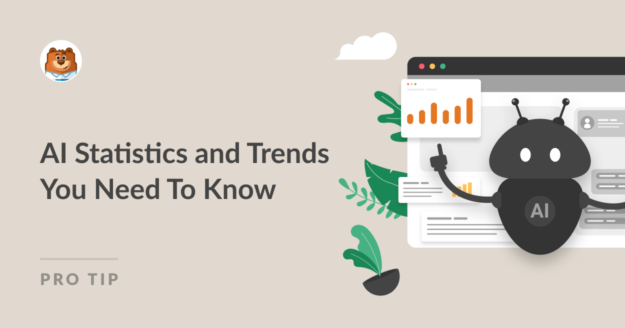As you’ll see from these AI statistics, just as the arrival of the internet in the 1990s completely transformed the way we worked and communicated, we’re now at the start of a new era driven by AI technologies.
From the staggering investments being poured into AI research and development to the increasing number of business owners embracing AI solutions, the numbers speak for themselves.
To try and better understand how the AI revolution has already impacted our business operations and take a better-informed guess at what might be in store in the coming years, I scoured some of the latest research studies into AI. I condensed what I found into this roundup of top AI statistics on how we’re currently using AI and what we should be aware of in the future of AI.
AI Statistics and Trends
In This Article
AI Market Growth and AI Adoption Rate statistics
The market for AI tools and platforms has experienced exponential growth in the last few years and this trend is expected to continue into the next decade.
As businesses recognize the efficiencies and competitive advantage that AI can offer, they are increasingly investing in the artificial intelligence market to streamline processes, enhance decision-making, and grow reach and revenue.
1. Statista measured the global AI market value to be 241.8 billion USD in October 2023 and predicted this would rise to 738.7 billion by 2030. Meanwhile, Next Move Strategy Consulting forecasts an even steeper rise, estimating the AI market size will reach around 1.85 trillion U.S. dollars by 2030. (Statista)
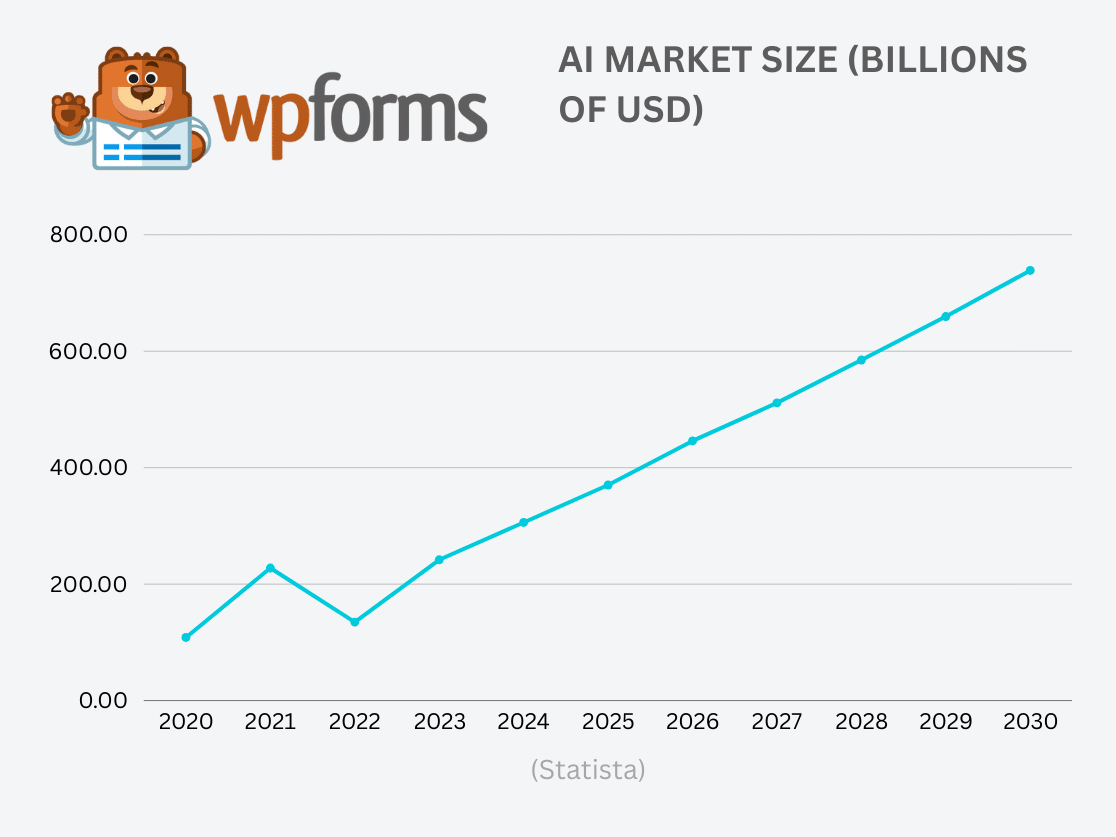
2. AI is expected to contribute a 21% net increase to the GDP of the United States by 2030 (Statista)
3. 73% of US companies are already using AI in some aspect of running their business. (PWC)
4. Banking was the industry spending the most on AI in 2023, at 20.64 billion USD, followed by retail at 19.1 billion USD. (Statista)
5. Companies investing in artificial intelligence are currently experiencing increased sales ROI of 10-20%. (McKinsey & Company)
6. Three out of every five senior sales and marketing executives interviewed by McKinsey research believed the impact of AI on lead identification would be significant. (McKinsey & Company)
7. ChatGPT dominated the AI tools space at the end of 2023 with a 60% market share. Other popular tools include Quillbot, an AI writing assistant (4.68% market share), the Midjourney image generator (2.06%), and Google’s Gemini chatbot (1%) (Tech Digest)
8. A staggering 97% of mobile device users already use AI-powered voice assistants like Siri and Alexa. (IDAP Machine Learning)
9. The AI app sector generated $2.5 billion in 2022 and is expected to grow at a compound annual growth rate (CAGR) of 38.3% until 2028. The top-grossing AI app this year was FaceApp, generating over $100 million in revenue. (Business of Apps)
10. More than one in four of the dollars invested in American startup companies in 2023 went to AI startups – more than double the figure of the year before. (Crunchbase)
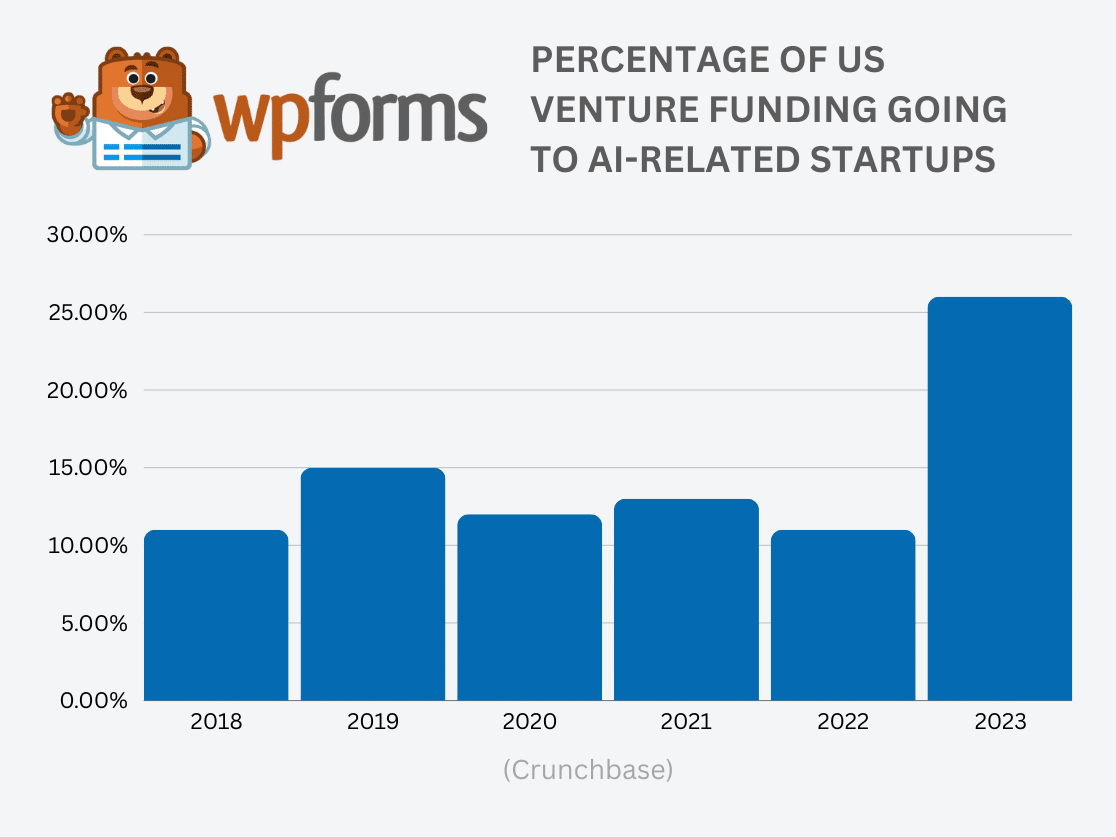
11. There are over 58,000 AI companies operating globally, with a quarter of these being based in the USA. (Springs Apps)
12. It’s expected that 97 million people will work in the AI industry by 2025, creating new jobs. (World Economic Forum)
13. The AI software market’s annual revenue is over $50 billion and is expected to reach $100 billion by 2025. (Omdia)
14. There are 25 National AI Research Institutes in the USA and the Biden Administration announced $140 million in funding to support this research in 2023. (The White House)
Statistics on the Use Cases of AI in Business
As business leaders begin to see how helpful AI applications can be in many different industries, they are experimenting with AI solutions to streamline processes, automate repetitive tasks, and come up with new ideas.
In this section, we’ll take a look at some interesting facts and figures that show how businesses in different fields are using AI. From how many companies are using this new technology to the specific ways they’re using it, these statistics will give you a good idea of how AI is changing the way businesses work.
1. 15% of organizations are using AI tools in their lead generation and content marketing strategies. (Content Marketing Institute)
2. 90% of marketers who use AI say it’s effective for content creation. 67% of marketers useAI tools to create content faster and half believe that it improves the quality of their content. (Hubspot)
3. The top cited barriers to successful AI adoption by enterprises include limited skills and expertise (33%), too much data complexity (25%), ethical concerns (23%), difficulty in integration and scaling (22%), high price (21%), and lack of tools for development (21%). (IBM)
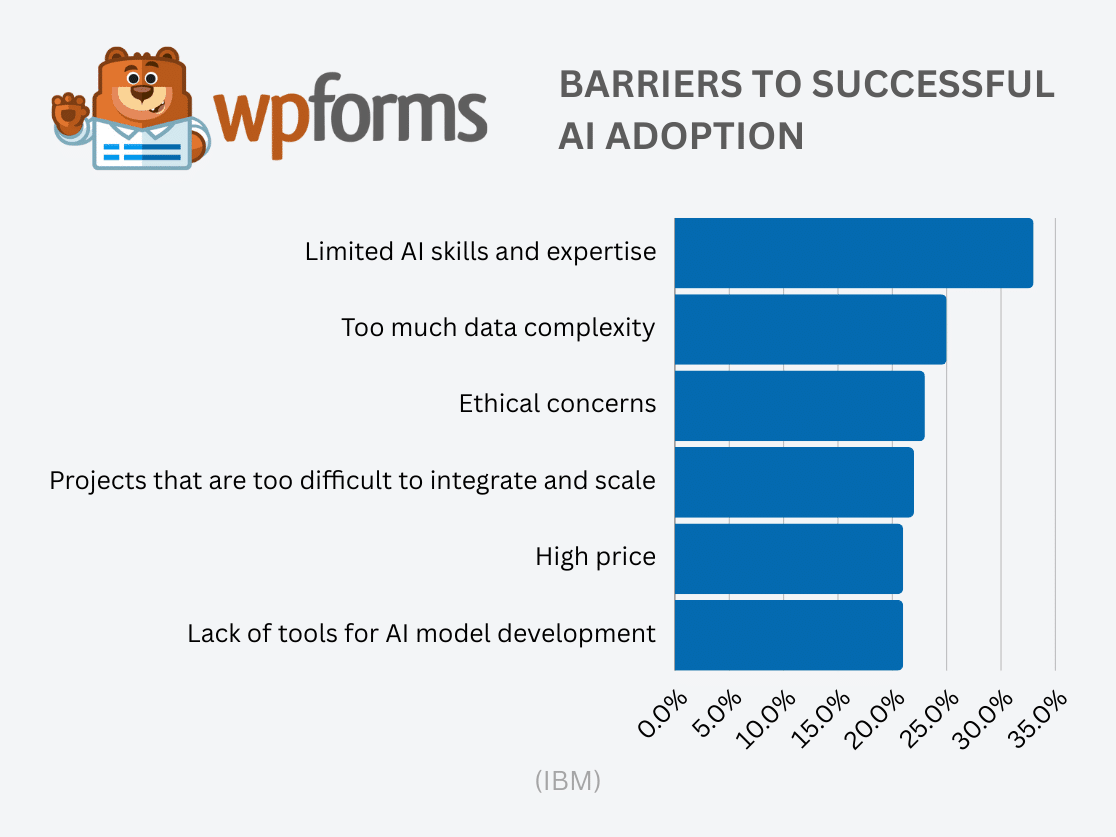
4. One in five organizations say they do not have employees with the right skills to use AI tools and 16% can’t find new hires with the skills to fill the gap. (IBM)
5. Organizations in India (59%), the UAE (58%), Singapore (53%), and China (50%) are most active in their AI usage, while AI uptake is lower in Spain (28%), Australia (29%), and France (26%). (IBM)
6. Businesses are currently using AI for a wide range of purposes with the most popular uses including customer service (56%), cybersecurity (51%), digital personal assistants (47%), customer relationship management (46%), inventory management (40%), content production (35%), and product recommendations (33%). (Forbes)
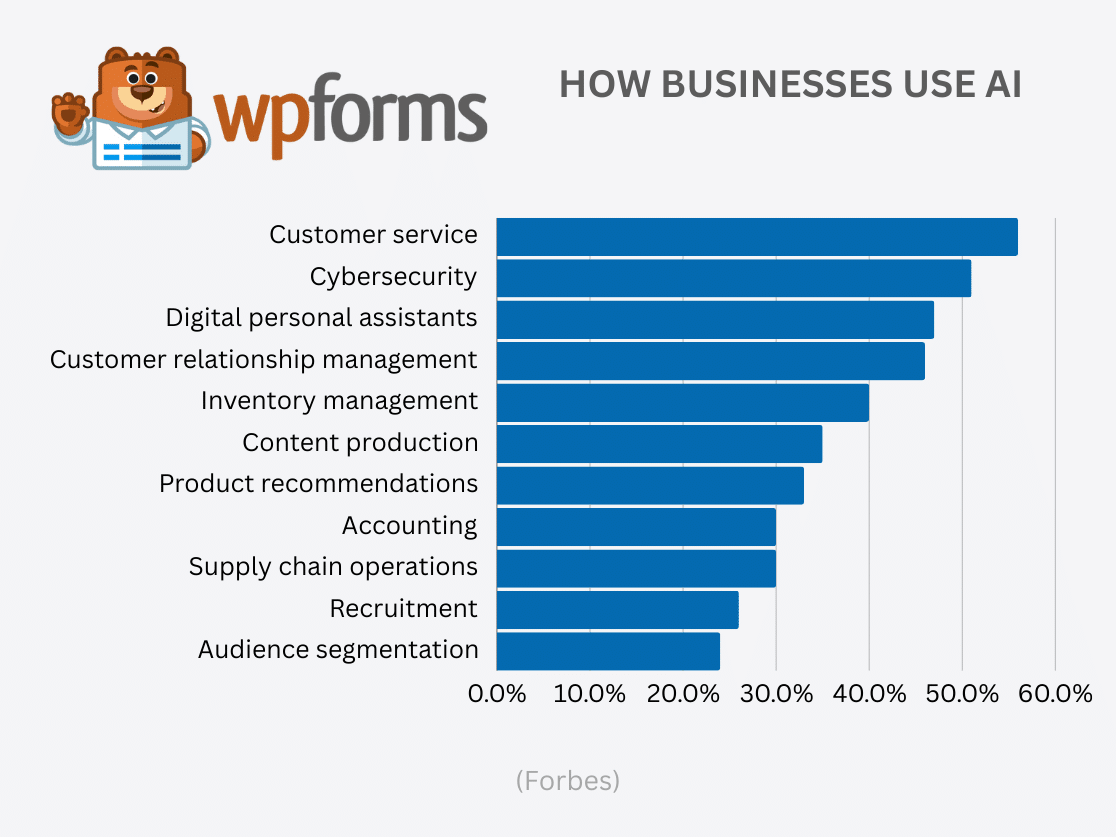
7. AI can be particularly valuable for improving the customer experience, with 73% of businesses using or planning to use AI chatbots, 61% to optimize and improve emails, and 55% to provide personalized services. (Forbes)
8. A staggering 90% of businesses believe ChatGPT will positively impact their business within the next 12 months. 70% believe it will help them to create content more quickly, 58% say it will help them to create a personalized experience for their customers and 57% believe it will help to increase web traffic. (Forbes)
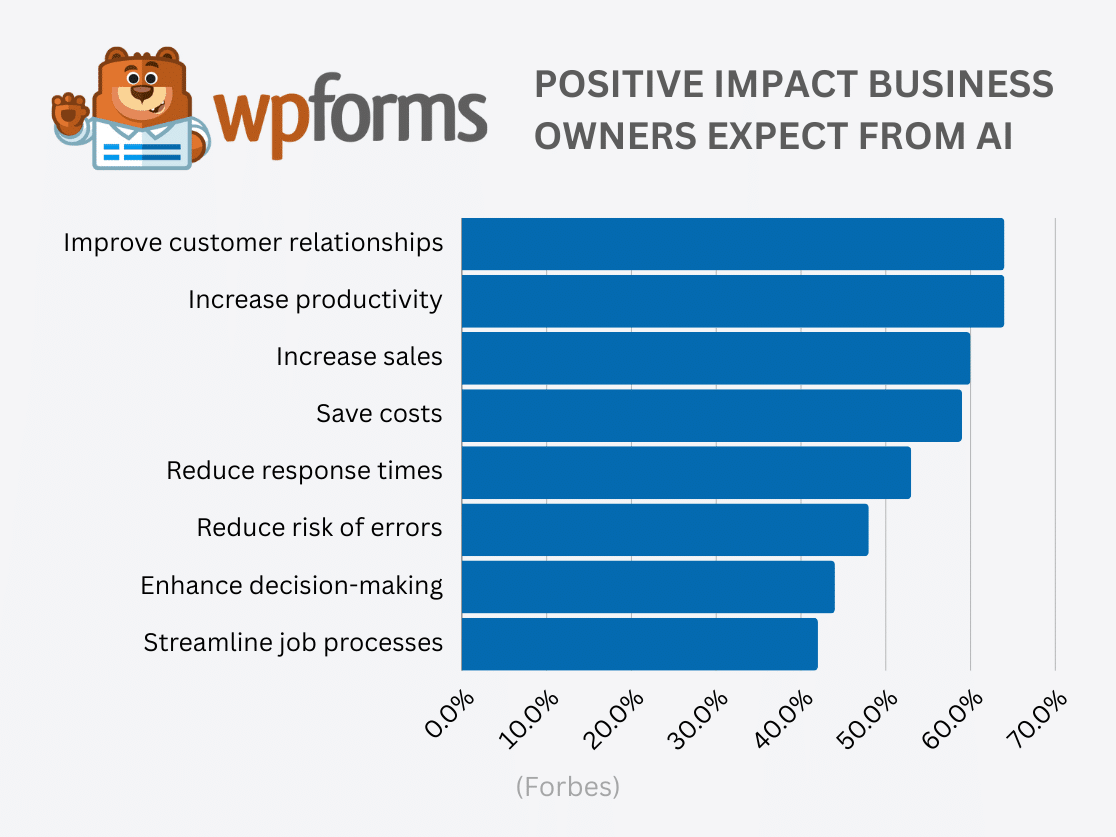
9. Over 40% of businesses are concerned they are becoming over-reliant on technology since the start of the AI boom. (Forbes)
10. An estimated 34% of all business tasks today are performed by AI and machines (World Economic Forum)
11. Over 80% of Fortune 500 companies started using ChatGPT within 9 months of its launch. (OpenAI)
12. 33% of businesses are already using or plan to use ChatGPT to write their website content, while 44% are planning to use its translation capabilities to write content in other languages. (Forbes)
13. Internally, the most popular use of AI in business is to improve production processes, with 53% of businesses using it for this purpose. Other popular uses include SEO tasks (52%), process automation (51%), internal communications (46%). (Forbes)
AI Marketing Statistics
An increasing number of companies are using AI to help them understand their customers better, create super targeted ads, and come up with new ideas and inspiration.
The artificial intelligence statistics below show just how much AI is shaking things up in the world of marketing, including how it’s helping them connect with customers and the benefits that AI offers for marketing teams.
1. Over half of the email marketers surveyed in 2023 believed that AI-supported email marketing was more effective than traditional email marketing. (Statista)
2. Almost a third of marketers now say they use generative AI to assist in creating and replying to emails. (Hubspot)
3. 71% of respondents to a survey of marketing professionals say that using AI has resulted in positive ROI and 72% believe AI makes them more productive. (Hubspot)
4. The top uses of AI in marketing automation include creating content (48%), analyzing and reporting on data (45%), learning how to do things (45%), and conducting research (32%). (Hubspot)
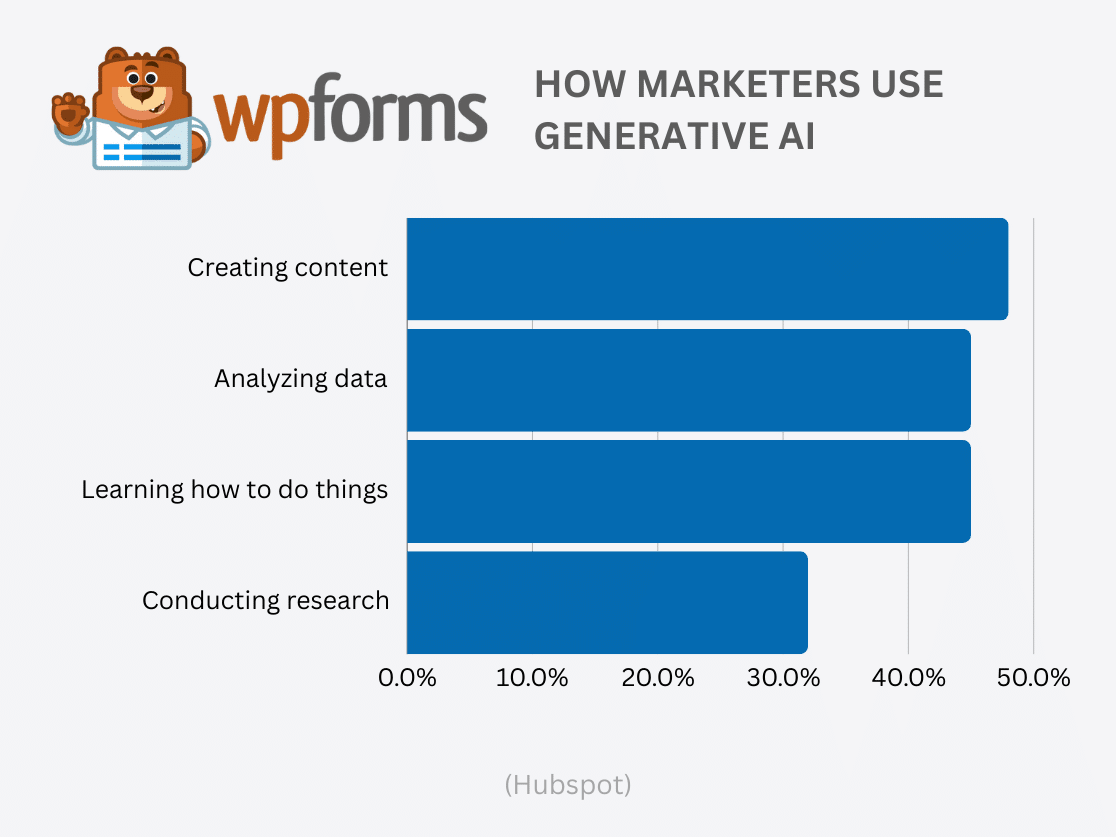
5. 90% of marketers agree AI and automation help them to be more efficient and spend less time on manual tasks. (Hubspot)
6. Only 5% of marketers rely entirely on AI to write content for them. The rest use AI to help with inspiration and ideation, for outlining content, and for getting started with a few paragraphs. (Hubspot)
7. The most common way marketers use AI-assisted writing is to make minor edits, with 53% of marketers using AI tools to polish their content before publication. 39% say they use AI to make major edits and 5% admit they leave AI to change the text completely. (Statista)
8. B2B marketers are most likely to use AI for coding, with 31% saying they use AI tools for this purpose. Other common uses include Chatbots (31%), design (31%), presentations (30%), content (30%), productivity (29%), website development (26%), automation (23%), and video creation (18%). (Statista)
9. 37% of people working in marketing or advertising had used generative AI by early 2023. (Statista)
10. 88% of marketers believe they need to increase their use of AI and automation in order to stay competitive and meet customer expectations. (Mailchimp)
11. Jasper.ai was the favorite AI tool of marketers at the end of 2023, with almost a third citing it as their tool of choice. (Influencer Marketing Hub)
12. Lack of understanding was cited as the main reason for marketers not yet using AI at work (41.9%). Other common reasons included high cost of implementation (23.7%), concerns over data security and privacy (12.9%) and uncertainty over ROI (10.8%) (Influencer Marketing Hub)
13. Using predictive AI to create highly personalized email campaigns can reduce cart abandonment by 18%. (Drip)
14. 20% of marketers in 2023 spent over 40% of their marketing budget on AI-driven campaigns. (Influencer Marketing Hub)
AI Use in Lead Generation and Sales
AI is revolutionizing lead generation and sales effectiveness by helping businesses identify, attract, and convert potential customers more effectively.
AI-powered tools can predict which leads are most likely to convert, personalize outreach efforts, and optimize sales strategies.
1. More than half of the businesses that use conversational AI for lead generation agree it’s helped them to generate higher quality leads. (Yellow.ai)
2. Enterprises can see a 15-20% increase in sales productivity by using AI for lead generation. (SalesFuse)
3. Over 40% of sales leaders using AI tools said their lead prioritization, use of salespersons’ time, and understanding of customer needs has improved. (Salesforce)
4. High sales performers are 2.8x more likely to use AI than low performers. (Salesforce)
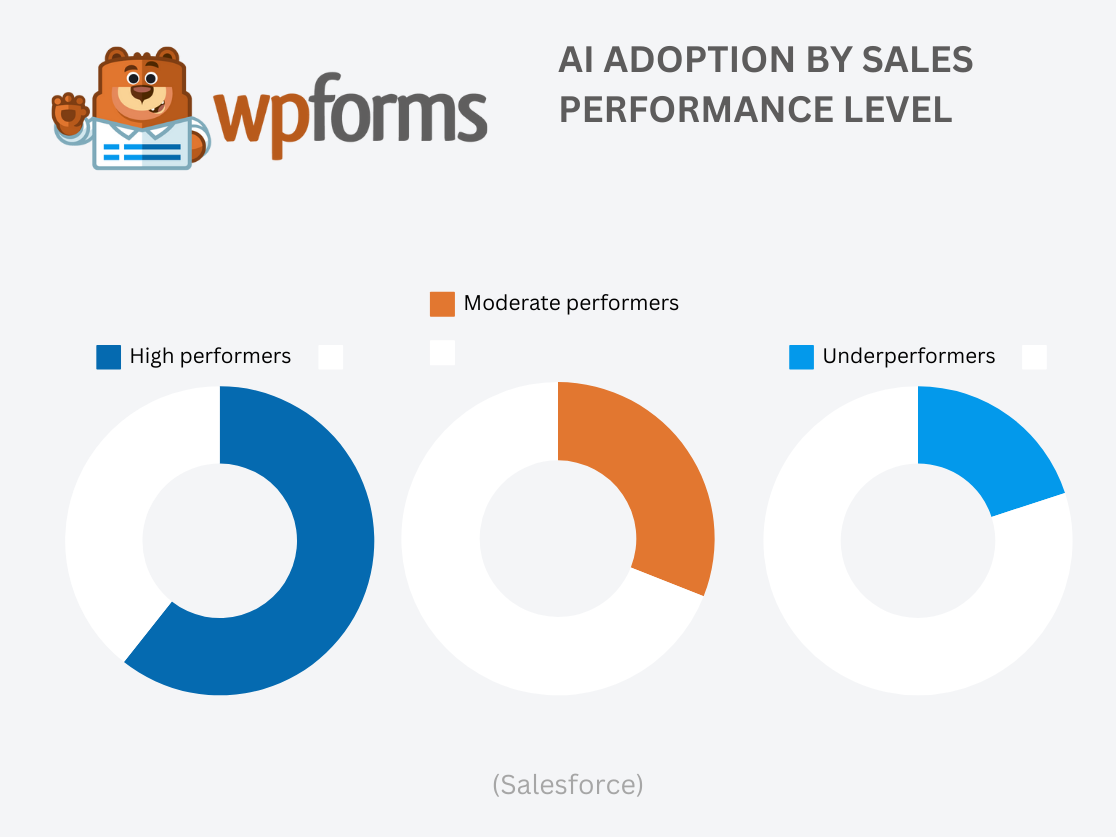
5. 40% of businesses have planned or are already increasing their investment in AI for lead generation purposes. (Salesforce)
Consumer Trends in AI
As AI technologies become more sophisticated and accessible, they are increasingly influencing consumer behaviors and expectations.
From personalized recommendations and virtual assistants to automated customer support, AI is changing the way consumers interact with brands and make purchasing decisions.
1. Over three-quarters of consumers are concerned that AI will have a negative impact on employment and will cause job losses within the next 12 months. (Forbes)
2. Economists estimate that two-thirds of the current jobs in North America could be at least partially automated with AI systems, replacing up to half the current workload. (Goldman Sachs)
3. 54% of consumers believe they can tell the difference between human-written and AI-generated content. (Forbes)
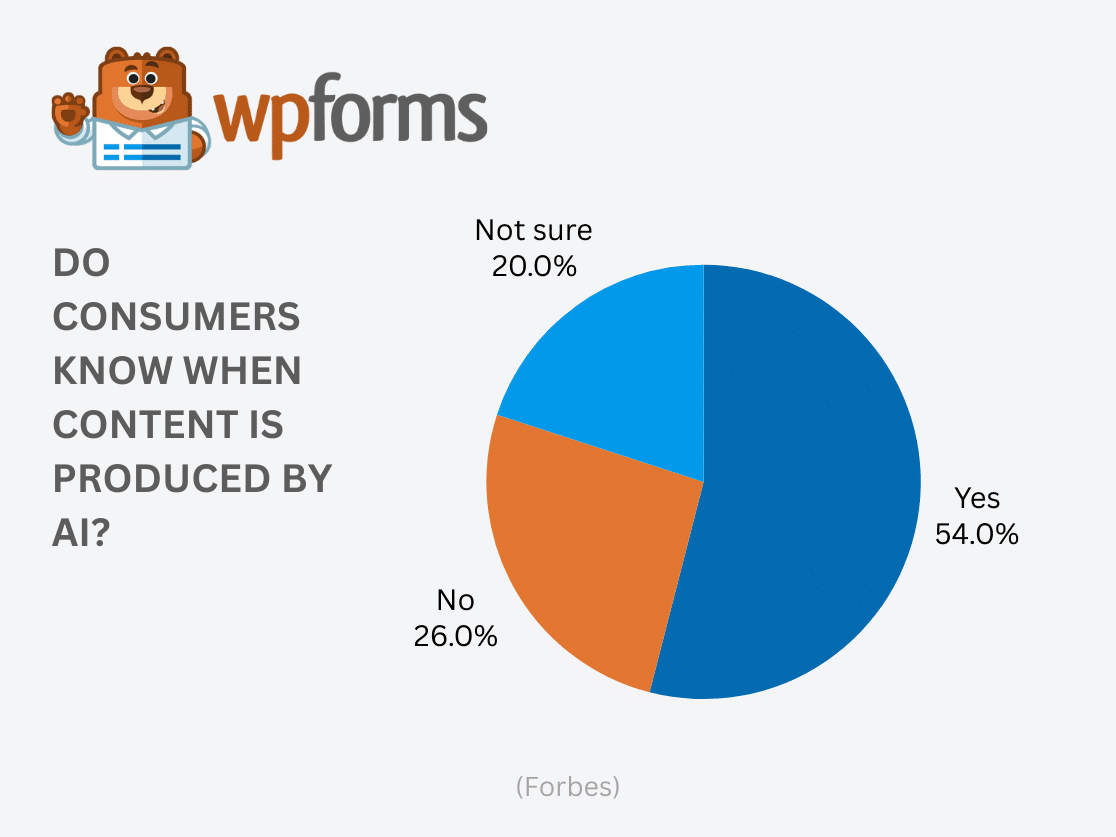
4. Over 65% of consumers say they would use ChatGPT or a similar AI tool instead of a Google search. (Forbes)
5. In general, younger generations are more open to the idea of AI, with 66% of Gen-zers saying they would be interested in an AI assistant that walks them through a website or product feature, compared to only 52% of consumers overall. (Survey Monkey)
6. 46% of US adults think AI technology is being developed too fast. (Ispos)
7. Top uses for AI among consumers include replying to texts and emails (45%), finding answers to financial questions (43%), putting together travel itineraries (38%), writing emails (31%), getting ready for job interviews (30%), creating social media posts (25%), and summarizing complex or lengthy information (19%). (Forbes)
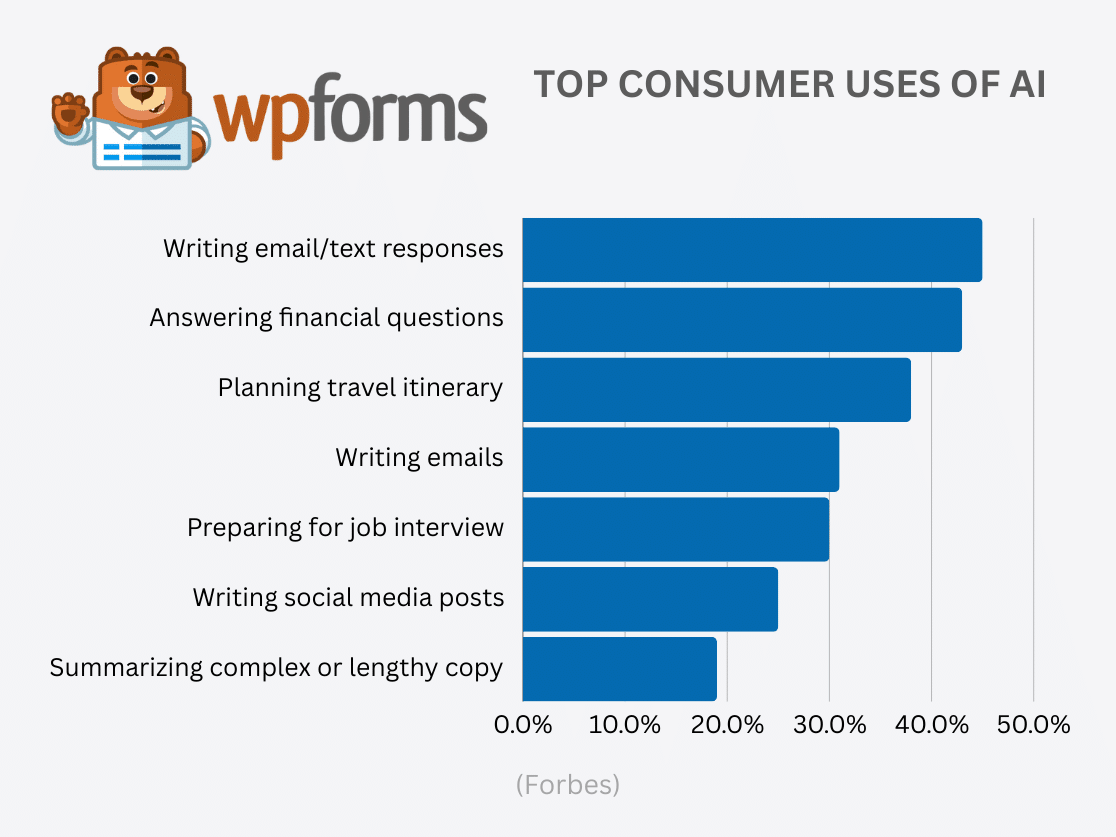
8. 75% of consumers are concerned about misinformation from artificial intelligence. (Forbes)
9. ChatGPT is the fastest-growing consumer application in history, gaining 100 million monthly visitors only two months after launch. (Reuters)
10. The Net Promoter Score (NPS) satisfaction metric is an average of 72 points higher for human customer service agents than it is for AI-powered chatbots. (Survey Monkey)
11. 36% of global workers believe AI will replace their current job. (Ispos)
12. 27% of Americans interact with AI several times a day (Pew Research)
It’s clear that AI will continue to shape the global economy in profound ways as the growth of AI accelerates.
Business owners, CEOs and other business leaders need to stay on top of the latest AI statistics, trends and use cases to understand how best to leverage AI providers and solutions.
The coming years will bring many more exciting AI applications as this new technology matures.
Next, Discover Some New AI Tools For Your Business
Feeling inspired to give AI a greater role in your business this year? Check out our roundup of AI tools for small businesses to find out more about how you can use AI to create chatbots, power your CRM, automate your marketing, and help with content creation.
Some key advancements include natural language processing (NLP) and deep learning algorithms that allow AI to understand and respond to human language more naturally. These forms of AI are powering chatbots, virtual assistants, and other language-based AI applications.
And did you know, you can use WPForms with ChatGPT to send AI-generated notifications?
Create Your WordPress Form Now
Ready to build your form? Get started today with the easiest WordPress form builder plugin. WPForms Pro includes lots of free templates and offers a 14-day money-back guarantee.
If this article helped you out, please follow us on Facebook and Twitter for more free WordPress tutorials and guides.

